23 Feb 2015
Pododermatitis in rabbits: an under-recognised problem
From the <em>Vet Times</em> archives – Elisabetta Mancinelli discusses research that led to the creation of a scoring system for the clinical assessment of hock lesions.

Figure 4. The picture shows a lesion, extending linearly along the plantar aspect of the metatarsal area, with evident alopecia, erythema and scaling of surrounding tissues (grade two of the pet rabbit pododermatitis scoring system).
Pododermatitis – often called “sore hocks” – is a chronic, granulomatous, ulcerative dermatitis, which most commonly affects the plantar aspect of the caudal metatarsal and tarsal areas of rabbits.
Less frequently, the palmar aspect of the metacarpal and phalangeal surfaces of the front feet may be involved, often occurring secondary to a shift of the rabbit’s weight from the hind to the front feet in an attempt to relieve the pain associated with this condition (Harkness et al, 2010).
At rest, rabbits bear their weight on the area between the hock and the hind claws, but during locomotion they are digitigrades, placing their weight on the digits and claws rather than on the metatarsi and hocks. Furthermore, differently from dogs and cats, rabbits only have thick fur to protect the plantar aspect of their hind feet – lack footpads and the thin skin associated with this area is adhered to the underlying tissues (Harcourt- Brown, 2002). This area is often overlooked during a physical examination of pet rabbits.
The animal should be handled safely and correctly (Figure 1), then the fur covering the plantar aspect of the caudal metatarsal and tarsal areas should be parted to expose the skin and allow close examination of lesions (Figure 2).
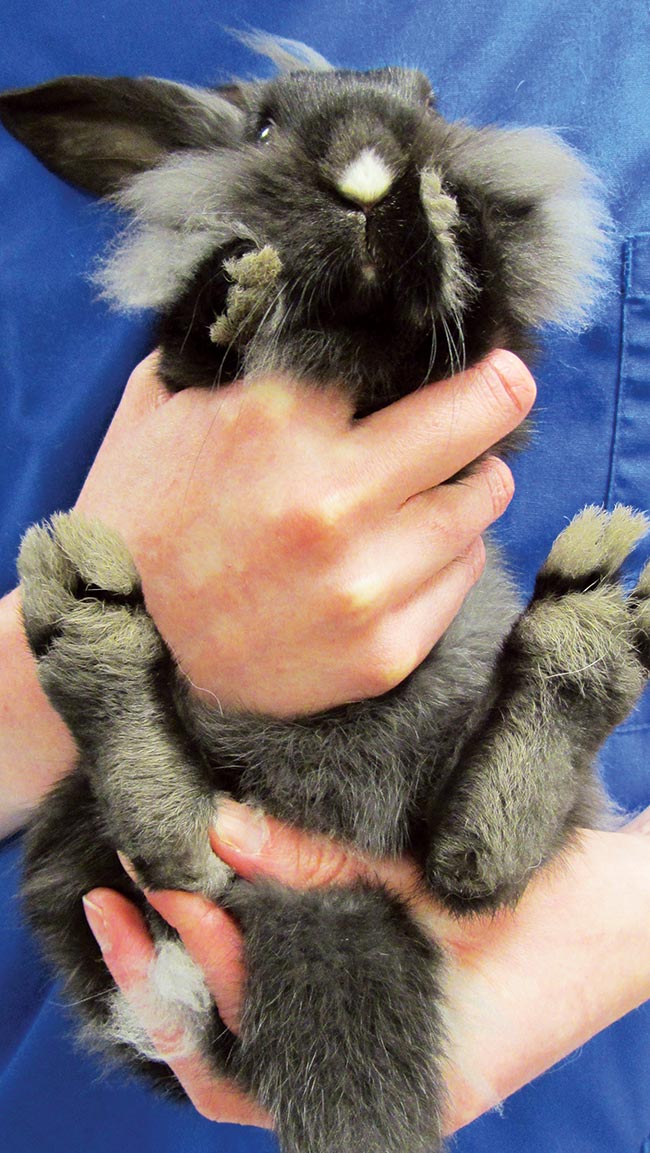
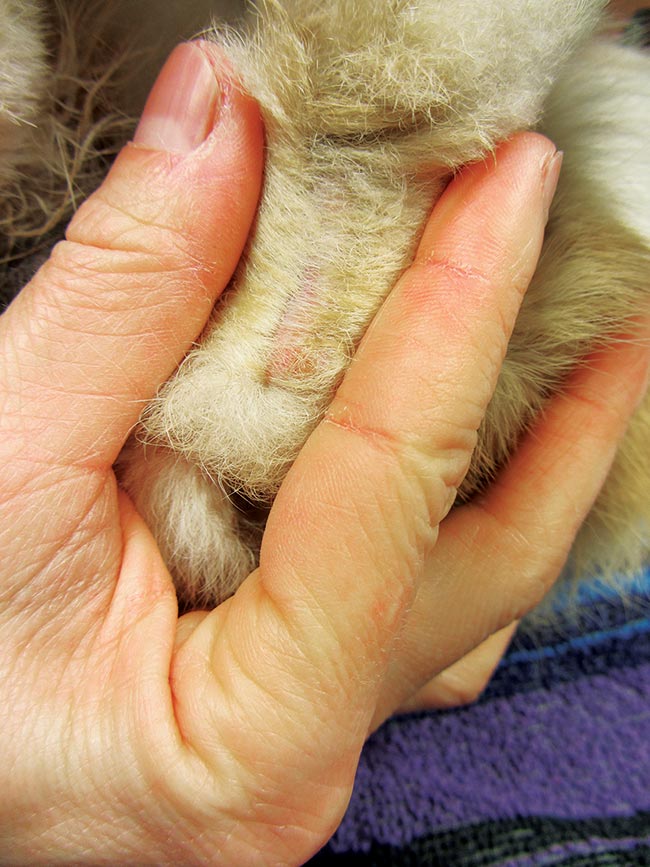
Some consider ulcerative pododermatitis a serious and painful condition that can rapidly progress and potentially compromise the health and welfare of rabbits (Webster, 2001), even when only a callus is present on the plantar aspect of the foot (Drescher and Schlender-Böbbis, 1996). Other authors (De Jong et al, 2008) questioned whether minor lesions are associated with pain in rabbits, but they underlined how callus formation may increase the risks of more severe abnormalities occurring, which poses a clear welfare issue.
Despite rabbits being very popular pets nowadays, the majority of the publications on pododermatitis in this species have been derived from studies performed in animals kept under laboratory or farm conditions.
Commercial and laboratory settings
For commercial rabbits, factors predisposing to pododermatitis include:
- animal origin
- weight
- body condition
- age
- sex
- concurrent diseases
(Rosell et al, 2000; Rosell and de la Fuente, 2004; 2008; Hago et al, 1987).
Pododermatitis, in animals kept in intense farmed conditions, is considered mainly secondary to physical/conformational or husbandry-related problems. These occur, for example, when animals are confined in small cages housed on hard or wire flooring, because the trauma due to persistent contact with various types of rough, dirty flooring can lead to ischaemia and avascular necrosis of the plantar surface of the foot (Rommers and Meijerhof, 1996).
Locally applied pressure, friction and shearing forces with subsequent ischaemia reperfusion and tissue necrosis are also considered predisposing factors for development of pressure ulcers (bedsores or decubitus ulcers) in humans (Nguyen et al, 2008).
Any condition that compromises locomotion and the mechanism of weightbearing can ultimately increase the pressure on the thin, soft skin and the underlying bones of the rabbit’s feet, resulting in ischaemia and avascular necrosis (Harcourt- Brown, 2002; Oglesbee, 2006). Conditions commonly associated with these events include obesity, spinal pain, lack of exercise or immobility due to other causes, and clipping the fur around the foot (Richardson, 2000).
Focal hair loss, erythema, scaling, and ulceration of the skin of the plantar surface over the bony prominence of the metatarsus are frequently seen initial clinical signs (Richardson, 2000).
It has been hypothesised the predisposing factors leading to ulcerative pododermatitis in farm and laboratory rabbits may be similar for pet rabbits (Harcourt-Brown, 2002). However, laboratory settings and farm conditions are in contrast to the situation of pet rabbits presenting to local veterinary practices for routine care.
The pet rabbit population is not composed of relatively few breeds and animals are not housed under controlled conditions. Furthermore, in the laboratory situation, many rabbits are sacrificed at an early age, whereas the normal lifespan of a pet rabbit can reach, on average, from 9 to 11 years (Carey and Judge, 2000).
Research
Harcourt-Brown (2002) stated pododermatitis is a common clinical finding in the pet rabbit population, but, until recently, no data were available regarding the actual prevalence of this condition in the UK pet rabbit population or possible husbandry-related factors that may predispose pet rabbits to development of this condition.
This was the aim of a study that set out to determine the prevalence of pododermatitis within a sample pet rabbit population and identify possible correlations with husbandry, sex, breed and origin of the rabbits (Mancinelli et al, 2014).
Results
The data collected showed pododermatitis is a frequently encountered problem, with a 93.8% prevalence in the sampled pet rabbit population in the UK, and that many of the risk factors previously identified as potentially increasing the incidence of pododermatitis in commercial animals are similar for pet rabbits.
Results of this study were striking because, of the 179 rabbits surveyed, only 11 showed no signs of pododermatitis, with the remaining 168 rabbits presenting with varying degrees of lesions.
Age
The findings suggested young rabbits are at a lower risk of pododermatitis compared to older rabbits. This would be consistent with the theory pressure-related ulcers are the product of compression over a period of time (Kosiak, 1961).
Sex and neutering status
Female domestic rabbits appear to be more predisposed to pododermatitis than males. When the effect that neutering may have on the incidence of pododermatitis was investigated, 100% of the neutered females examined showed clinical evidence of pododermatitis. Similarly, neutered males had a 54.9% prevalence of clinically major lesions compared to entire males (39.2%).
A communication by Courcier et al (2012) suggested female rabbits and/or rabbits that had been neutered may be more likely to be overweight. The incidence of pododermatitis has been clearly linked to bodyweight (Rosell et al, 2000; Harcourt-Brown, 2002) and body condition in farmed rabbits (Rosell and de la Fuente, 2008). It has also been suggested this is the case in pet rabbits (Harcourt-Brown, 2002).
In the 2014 study, those animals in the overweight category (body condition score greater than three) had a higher prevalence of pododermatitis at 97.4% compared to those rabbits considered to be at an ideal weight and those considered to be underweight (93.8% and 91.7%, respectively).
It can be speculated neutered female rabbits are more likely to be less active and more overweight and, therefore, more predisposed to pododermatitis development. However, further studies would be needed to evaluate the effect of activity levels on the development of such conditions and the correlation with sex.
Husbandry
The effect different types of bedding may have on the prevalence of pododermatitis in commercial rabbits has been extensively studied elsewhere (Rommers and Meijerhof, 1996; Harcourt-Brown, 2002; De Jong et al, 2008; Rosell and De la Fuente, 2008).
It is generally accepted the type of substrate on which a rabbit is housed has a great impact on the development of sore hocks (Rommers and Meijeroff, 1996) as it can affect the weight distribution, allowing most of the weight to be borne by the metatarsi. Furthermore, many types of flooring are abrasive and can cause friction and increased shearing forces, increasing the likelihood of sore hocks developing (Harcourt- Brown, 2002).
The 2014 study showed hay, compared to other types of bedding, is associated with a reduced incidence of pododermatitis. When other types of beddings (carpet, hard flooring, newspaper, straw, shavings, towels, blankets, recycled paper bedding, carpet or foam mats) were considered, no statistically significant correlation was found between any of those and the presence of pododermatitis, as 100% of the rabbits housed on these beddings presented various degree of lesions.
Other factors
The origin of the rabbit (whether from a breeder, home bred, from a rescue centre or a pet shop) was found not to have an influence on the prevalence of pododermatitis.
Rabbits are the third most popular pet in the UK after dogs and cats. However, rabbits are also the most neglected and misunderstood species, with large numbers (around 67,000 rabbits according to figures released by the Rabbit Welfare Association and Fund; RWAF, 2012) ending up in rescue and adoption centres every year. The aforementioned study showed 58% of rabbits examined were acquired as “rescues”.
Many owners buy a rabbit as an impulse without really understanding how demanding this pet can be and how complex it is to fulfill the needs of this unique species, which can ultimately pose serious welfare concerns for these animals.
The study’s results also showed a large variety of rabbit breeds being presented to the practice. This reflects the wide range of breeds available in the pet trade. The British Rabbit Council recognises many different breeds and more than 500 varieties of rabbits in the UK, which constantly evolve due to selective breeding practices (Meredith, 2006). Many pet rabbits are now cross-breeds (Meredith, 2006) and this observation was confirmed during this study, as the large majority of rabbits seen were cross-breed. Lop rabbits were also present in large numbers, followed by lionheads, Netherland dwarfs and Dutch rabbits.
Previous literature suggests commercial pet, recognised angora and rex rabbits as being more predisposed to developing pododermatitis due to their fine sparse hair, which offers limited protection to the metatarsi (Harcourt-Brown, 2002; Harkness et al, 2010). Flemish giant and other giant breeds are also considered more susceptible due to their increased weight (Harkness et al, 2010).
However, in the aforementioned study, it was not possible to analyse the association between breed and presence of pododermatitis as the large variety of rabbit breeds seen, with relatively small numbers within each group, and the large number of cross-breed rabbits precluded statistical analysis.
Scoring system
The extent and severity of lesions presented by the rabbits examined were also clinically scored by adapting existing systems (Rommers and Meijerhof, 1996; Niitsuma et al, 2003) to produce the pet rabbit pododermatitis scoring system (PRPSS). In this system, dermatologic signs were scored for severity from zero (no evidence of pododermatitis), one (mild; Figure 3), two to three (moderate; Figures 4 and 5), four to five (severe; Figure 6), to six (loss of pedal function).
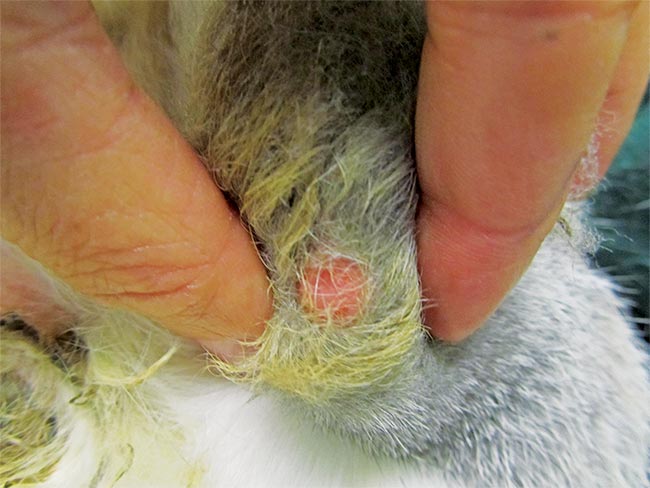
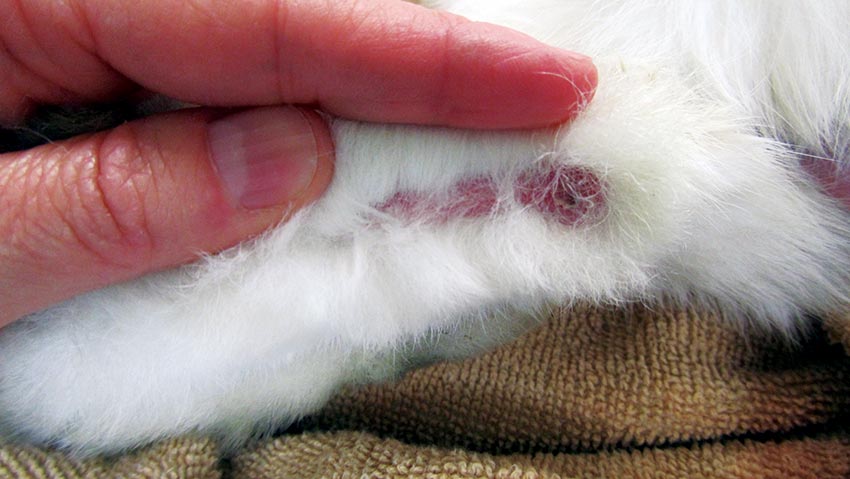
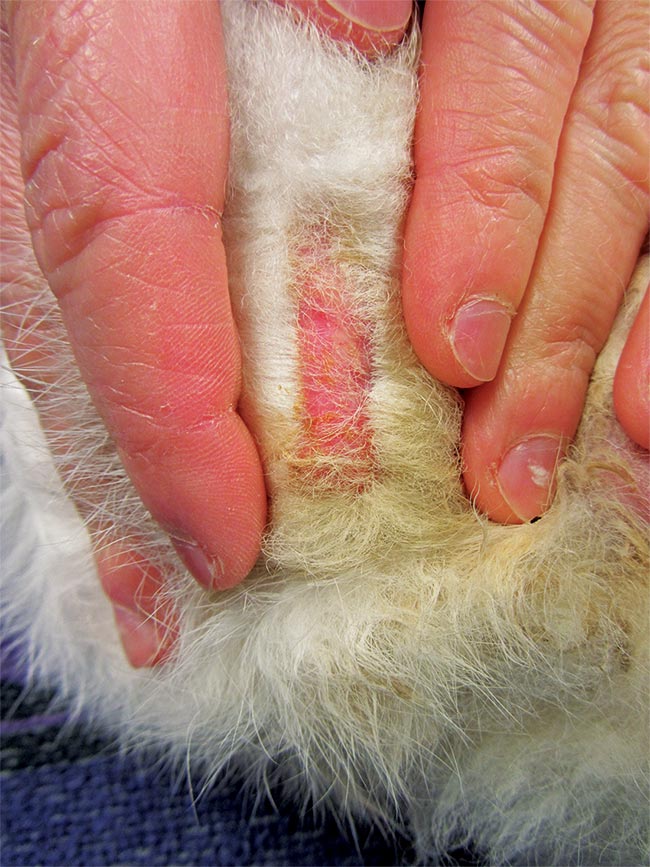
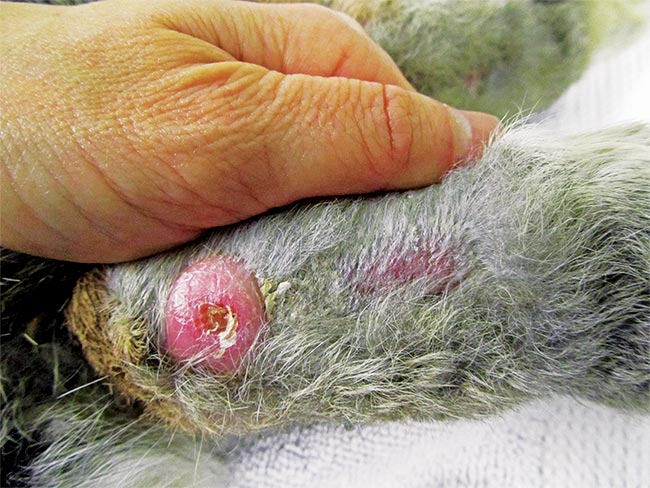
of pet rabbit pododermatitis scoring system).
Each grade was also associated with a macroscopic description of the dermatologic lesions observed at the metatarsi (“sore hocks”; Table 1) to allow easier identification of early stages, which may be important to enforce husbandry changes thus preventing development of more severe lesions.
| Table 1. The pet rabbit pododermatitis scoring system (PRPSS) was developed for clinical assessment of hock lesions. A macroscopic description of pododermatitis lesion from zero to six is based on the degree of pododermatitis present. Modified from Mancinelli et al, 2014. | |
|---|---|
| Grading scale | Macroscopic description |
| Grade 0 | No evidence of pododermatitis. |
| Grade 1 | A localised, circular area is present on the plantar aspect of the metatarsal bone-calcaneus, with minimal alopecia, hyperaemia and/or hyperkeratosis of the skin. |
| Grade 2 | Lesions are extending linearly along the plantar aspect of the cranial metatarsal area with alopecia, erythema and scaling of surrounding tissues. |
| Grade 3 | Associated infection of subcutaneous tissue may be present. |
| Grade 4 | Full thickness skin loss with swelling and necrotic debris can be associated with infection of underlying tissues. |
| Grade 5 | Severe infections with involvement of deep structures including bones and tendons. |
| Grade 6 | End stage disease with loss of pedal function. |
Conclusion
The research provides clear evidence husbandry and captive management have a great impact on the development of pododermatitis in pet rabbits. This project also produced a scoring system that can be used by veterinarians in practice to score clinical cases and help their decision-making on treatment recommendations. Its clinical importance therefore relies in the identification of those factors that can predispose pet rabbits to pododermatitis.
It hopefully also represents the first step towards increased awareness of this extremely common problem that many pet rabbit owners are unaware of and is often underestimated by many veterinarians.
Nevertheless, a larger study allowing investigation of a greater sample population and the identification of further risk factors is recommended by the author. This would significantly aid our understanding of the aetiology of pododermatitis in pet rabbits and enable the production of clear recommendations for the prevention and management of this serious condition.
